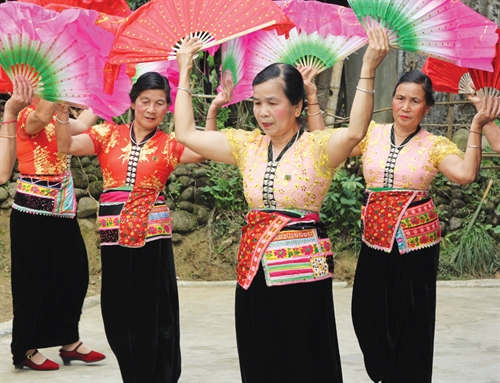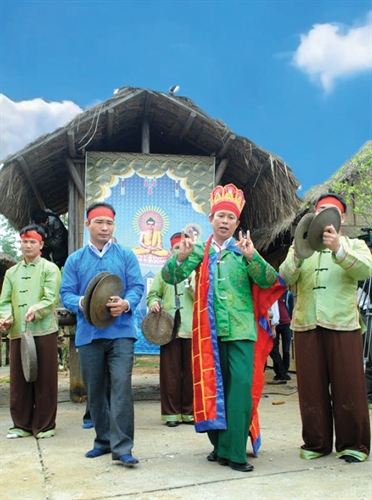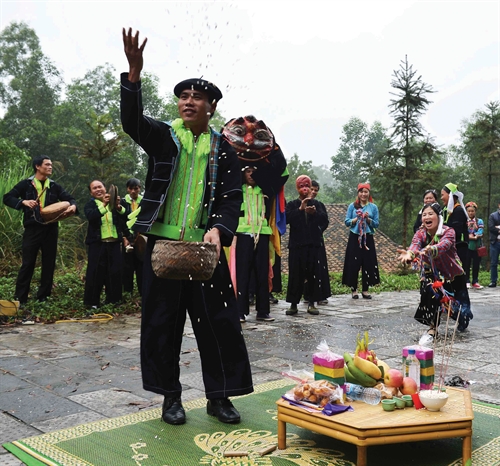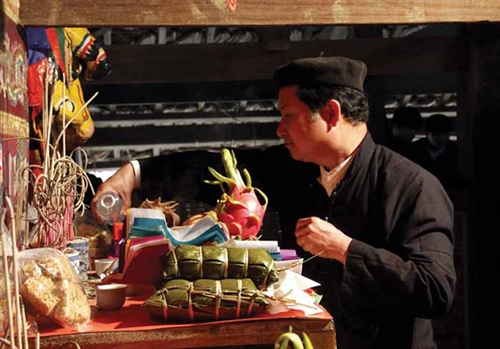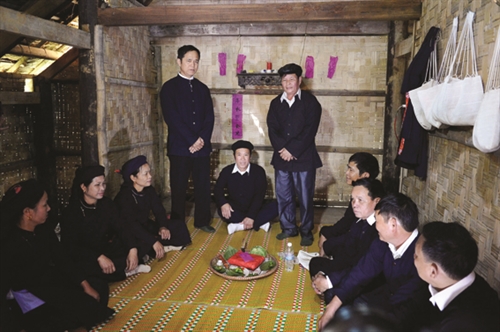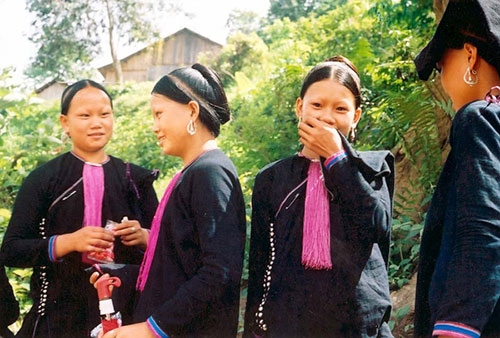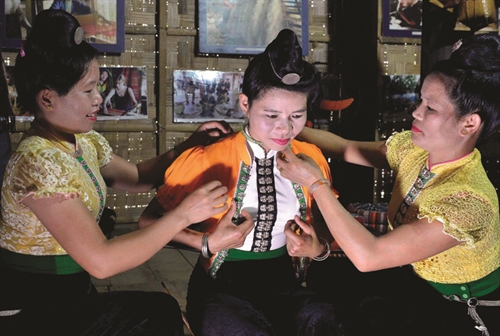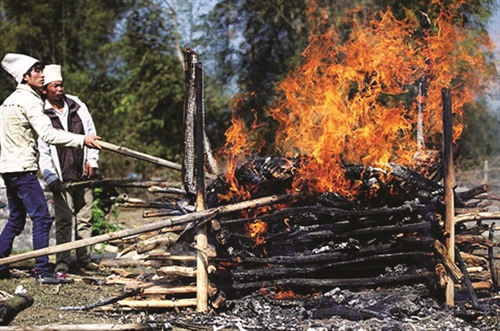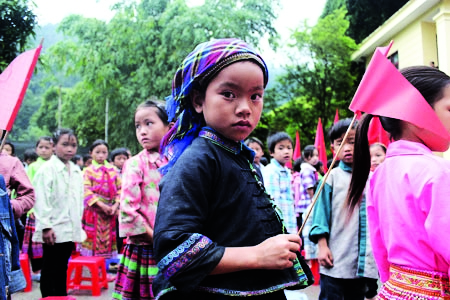>>Ancestor veneration in Tay Muong community
>>Conventions and practices of "Muong" ethnic minority
>>Long Tong, unique farming ritual of the Tay
>>Community spirit strengthens Tay people
Ta Thi Tam
Ethnology Institute
Building a house is an important event for the Tay Muong who hold solemn ceremonies at different stages of the construction process to win the gods’ protection for the family when they move in the new home.
The Tay Muong choose to build their houses between the ninth lunar month and the first of the following year when they have harvested crops and the weather is favorable for construction. A family which unfortunately has its house collapse will only build a temporary shelter, waiting for the right time to build a new one.
The Tay Muong make careful preparations for building a house, from choosing timber and other building materials to finding a suitable construction site and selecting dates and hours for digging the foundation, erecting pillars and roofing. At every construction stage, a ritual is held to win gods’ favor for a smooth construction process.
Choosing construction site and direction for the house
This is the first ritual a Tay Muong family is supposed to do when planning to build a new house. This ritual must be done by a shaman or an old man who is conversant with house building formalities.
The Tay Muong do not build their house looking east or west to avoid direct sunlight to the house. A house is also not supposed to face straight the nearest mountain peak.
Before deciding on the site for building their house, a family must see if the land is good or not by one of the following ways:
Divination by rice: The family head places an offering tray of two rolls of cloth, betel and areca and a bottle of liquor in the middle of the selected land lot for a shaman to conduct a rite asking for gods’ advice about the house’s site. The family head then digs a hole about 40cm deep, puts a stone with three rice seeds on it in the hole and covers the hole with another stone. The three seeds symbolize three wishes for good health, growing cattle herd and bumper crop. Three days later, the family head visits the site. If the rice seeds stay still, it is a good omen implying that the family can build their home on that land. If any of the seeds moves, particularly the one symbolizing health, the family would better choose another place to build their house.
Divination by bamboo string: The family head takes 12 bamboo strings of equal size, twists them in the middle, then ties two ends of each string together into a ring. Standing in the selected land lot with the bamboo rings in his hands, the family head recites prayers asking for permission from the god of earth to build a house on his land. After praying, the man throws out the bamboo rings. If all the rings fall onto the land separate from one another, then the family gets approval from the god of earth. If not, this land lot is believed not for the family.
Divination by egg: The egg used must be the first egg laid by a hen. The family head holds the egg in his hand or puts it in his pant pocket. Arriving the place chosen for his future home, he pretends to accidentally drop the egg. If it remains unbroken, this land is good for building a house.
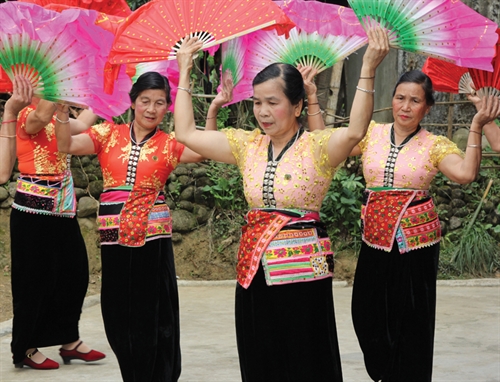 |
| Dancing performances by white Thai women (Lai Chau province) in their traditional Com costume__Photo: Quang Duy/VNA |
Informing gods of house building
Before building his house, the family head must hold a ritual right on the site of the house to ask the gods to support the construction. The ritual also aims to get community acknowledgement of the presence of a new family.
Offerings of the ceremony include a boiled rooster, a bottle of liquor and betel and areca, put on a tray placed on the ground. Putting a burning incense onto the offering tray, the shaman recites prayers inviting the god of earth to receive the offerings and asking for his permission for and protection of the house construction. Finishing the praying rite, the shaman pours a cup of liquor onto the ground three times.
Ground breaking
The date for starting construction is chosen carefully and must fall on the 2nd, 3rd, 14th, 15th, 26th or 27th of the lunar month as all the other dates are not good for home building in the Tay Muong’s belief.
The date chosen for the ground breaking ceremony is not supposed to be talked publicly by family members and villagers for fear of disturbance by evil spirits. The night before this ceremony, if the family head dreams of being taken to a field by a forest evil spirit or hears the sounds of a deer or muntjac, which is believed to be a bad omen, the ceremony must be put off.
Offerings of the ground breaking ceremony include a jar of liquor and a tray of nine dishes made from pork, chicken, fish and forest vegetables. The fish must be caught by the family head himself.
After the ceremony, the family head invites relatives and villagers to have a thank-you party as the family will receive help from the community throughout the construction.
Erecting pillars
The ground breaking ceremony is followed by a rite to erect pillars - the most important part of a house. Of these pillars, the three which are believed to be the shelter of the family ancestors, the spirit of the family head and the kitchen god, must be built first.
The Tay Muong never use a single log to make a pillar even if the log is big enough for building the whole house. They also do not choose secular or fallen trees or trees in cemeteries, believed to be the shelter of devils.
Of the three important pillars, the one sheltering the ancestors will be erected first to win their protection for the family. Then comes the one housing the family head’s spirit and last the pillar harboring the kitchen god.
Before erecting these pillars, the family head prepares a boiled chicken and liquor as offerings to the god of earth and places them at the hole for erecting the pillar symbolizing his spirit. He then prays for the god of earth’s permission for building the pillars and his support for the construction. After that, a man from the paternal family asks the family head which pillar will be built first and a man from a maternal family then answers for the family head that the ancestors’ pillar will be built first, then the family head’s pillar and last the kitchen god’s pillar before other pillars are built.
After this formality, relatives and villagers help the family erect the three pillars, which must be done before sunrise. If these pillars tilt because of rain, the family must ask a shaman to conduct a rite to restore the pillars before continuing construction. In this rite, the shaman explains the reason for the pillar restoration and asks for the gods’ permission and support for such work. After praying, he pours a cup of liquor onto the foot of the family head spirit’s pillar.
Roofing and kitchen building
The date for roofing a house must also be chosen carefully and must not fall on a date incompatible with the birth date of the family head. Women are not supposed to climb on the house frame to do the roofing, a work to be exclusively done by men.
Kitchen is spiritually meaningful to the Tay Muong as it is not only the place for cooking and warming the home but also the shelter of the kitchen god who supports the wellbeing of the family. The kitchen is where family members stay together to do daily work. When a family member dies, he will be laid next to the stove in the kitchen. The Tay Muong believe keeping the fire on at home makes the family life happy forever.
The kitchen is built last in the house construction with a wood frame and an earth floor. A Tay Muong home usually has two kitchens, one in the part for receiving visitors where a stove is placed for boiling water, and the other for cooking. Women are particularly interested in building the kitchen, the place attached to their life so they usually take charge of ramming the earth floor in the kitchen.
New home celebration
Before moving in a new home, a Tay Muong family must hold a ceremony to celebrate it. The date of this ceremony is chosen carefully by a shaman. In this ceremony, the wife is the first person entering the new home. She first lights a fire, places the sticky rice steamer at the corner of the kitchen, then puts a basket of rice paddies and one or two water containers on the floor, and finally takes mats and blankets into the sleeping room. After that, other family members carry into the house three trays of offerings for the family ancestors, the kitchen god and the god of earth. The family head recites prayers to thank the gods for their support throughout the construction process and ask for their protection for the family living in the new home. After the praying ritual, the family makes a feast for relatives and villagers to thank for their help.-
